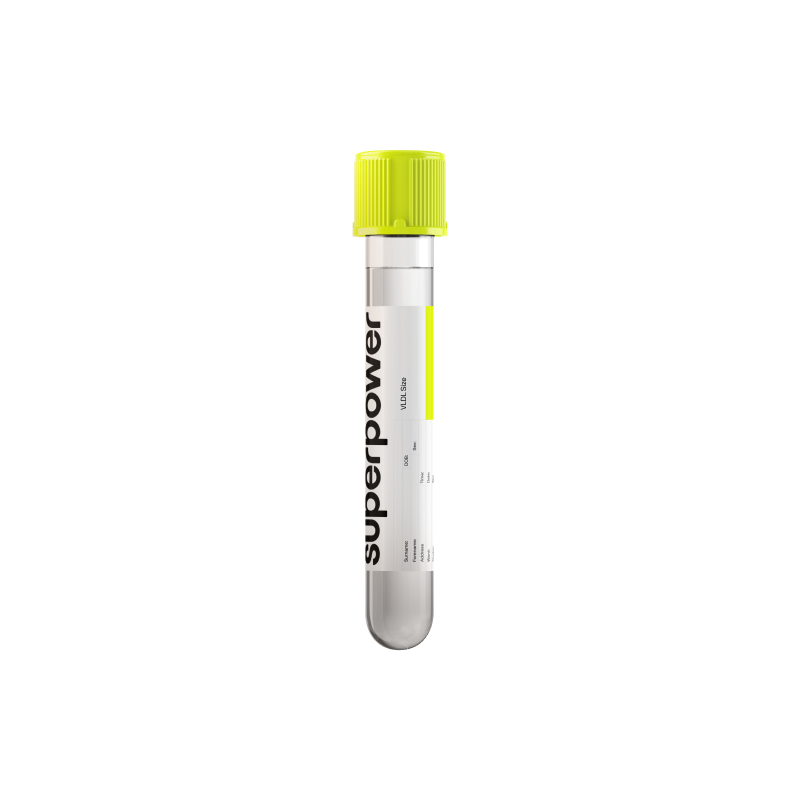Get a clearer view of how your liver packages triglycerides, how efficiently fat clears after meals, and how remnant burden links to your cardiometabolic risk.
This advanced marker helps turn complex lipid data into precise, actionable steps.
Key Benefits
- Check the size of VLDL particles that carry triglycerides in blood.
- Flag insulin resistance risk when VLDL size is larger than expected.
- Clarify causes of high triglycerides or fatty liver by identifying oversized VLDL.
- Refine heart risk by signaling higher triglyceride‑rich remnant burden beyond LDL.
- Guide diet or medication choices when triglyceride‑rich particles run large.
- Support pregnancy care by highlighting severe triglyceride patterns that raise pancreatitis risk.
- Track response to weight loss or glucose control as VLDL size normalizes.
- Best interpreted with fasting triglycerides, non‑HDL‑C or apoB, and A1c.
What is VLDL Size?
VLDL Size is the average diameter of the very low‑density lipoprotein particles circulating in your blood. These are fat‑carrying packages the liver builds and releases (VLDL, each with apolipoprotein B‑100) by loading a core of fat (triglyceride) with some cholesterol and wrapping it in a shell of phospholipids and proteins. In simple terms, it tells you how big the liver’s “fat parcels” are when they leave the warehouse.
What the size reflects is the cargo and the processing route. Larger VLDL are more triglyceride‑rich, and their size influences how quickly enzymes trim them (lipoprotein lipase and hepatic lipase), how they turn into intermediate remnants (IDL/VLDL remnants), and what kind of LDL particles they eventually become. VLDL Size also affects how these particles trade lipids with other carriers (cholesteryl ester transfer protein, CETP) and how much fat reaches muscles and fat tissue for use or storage. In this way, VLDL Size is a snapshot of the liver’s packaging strategy and the downstream traffic of triglyceride and cholesterol through the lipoprotein system.
Why is VLDL Size important?
VLDL Size reflects how large your very‑low‑density lipoprotein particles are—the liver’s triglyceride shuttles. Their diameter reveals how much fat those particles carry, how the liver is handling energy, and how strongly they interact with vessels to form cholesterol‑rich remnants that drive atherosclerosis. In most labs, values span a continuum; “healthier” tends to sit toward the smaller end, consistent with lower triglyceride load and fewer atherogenic remnants.
When VLDL particles are on the smaller side, they usually carry less triglyceride and are cleared efficiently. This pattern tracks with lower triglycerides, better insulin sensitivity, and fewer small, dense LDL particles downstream. It rarely causes symptoms on its own; when seen alongside very low triglycerides from chronic illness or undernutrition, any fatigue or nutrient issues reflect the underlying condition rather than particle size itself.
Larger VLDL particles signal triglyceride‑rich lipoproteins from hepatic overproduction, common in insulin resistance, abdominal obesity, type 2 diabetes, and fatty liver. These big particles shed cholesterol‑rich remnants and promote small, dense LDL formation, quietly raising cardiovascular risk. Most people feel nothing until triglycerides are very high, when pancreatitis (severe abdominal pain) or eruptive xanthomas can occur. Women often show higher VLDL size after menopause and during late pregnancy (a physiologic rise); children with obesity and teens with metabolic syndrome also tend toward larger VLDL.
Big picture: VLDL Size integrates liver fat export, insulin action, and vascular biology. Interpreted with triglycerides, apoB, remnant cholesterol, HDL, and liver enzymes, it helps gauge atherogenic particle burden and fatty liver risk, and, at extremes, the likelihood of hypertriglyceridemic pancreatitis.
What Insights Will I Get?
VLDL Size measures the average diameter of very‑low‑density lipoprotein particles the liver releases to carry triglyceride. It indicates how triglyceride‑rich these particles are and how well they’re cleared. This links liver fat handling, insulin sensitivity, energy delivery, and the atherogenic remnant load affecting cardiovascular health.
Low values usually reflect smaller VLDL particles from lower hepatic triglyceride packaging and efficient lipolysis (lipoprotein lipase). Physiology: better insulin sensitivity, lower triglycerides, fewer remnants, and less small dense LDL formation. Smaller VLDL is common in premenopausal women. Very low values can occur in low‑triglyceride states or rare hypolipidemias.
Being in range suggests balanced triglyceride export and clearance, stable post‑meal lipid handling, and a lower remnant cholesterol burden. Optimal typically sits toward the smaller end of the reference range, not at the extreme low.
High values usually reflect larger, triglyceride‑rich VLDL from hepatic overproduction and reduced clearance—seen with insulin resistance, visceral adiposity, fatty liver, too little thyroid hormone (hypothyroidism), pregnancy, alcohol, or certain drugs. Effects include postprandial lipemia, more remnants and small dense LDL, lower HDL, endothelial stress, and higher cardiometabolic and pancreatitis risk. Men and postmenopausal women tend to run higher.
Notes: Fasting lowers VLDL size versus non‑fasting. Pregnancy, acute illness, and medications (estrogens, steroids, retinoids, beta‑blockers, protease inhibitors) shift size upward. Different NMR or ion‑mobility methods use different cutoffs; compare serial results within the same lab.



.svg)



.png)
.png)
.png)
.png)








